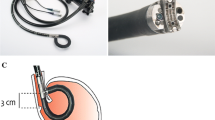Abstract
Background
The Plicator™ (NDO Surgical, Inc., Mansfield, MA) endoscopically places a full-thickness permanent suture to augment the antireflux barrier. At 3-years post-treatment, published results demonstrated a reduction in subjects’ gastroesophageal reflux disease (GERD) symptoms and related medication use.
Aim
To evaluate the Plicator’s safety and durability of effect at improving GERD symptoms at 5-years post-treatment.
Methods
A total of 33 chronic GERD sufferers across seven sites were followed for approximately 5 years (median follow-up: 59 months, range 50–65 months) after receiving a single full-thickness plication approximately 1 cm below the gastroesophageal (GE) junction in the anterior gastric cardia. At baseline, 30 out of 33 subjects required daily proton-pump inhibitor (PPI) therapy.
Results
Of the subjects who were PPI dependent prior to treatment 67% (20/30) remained off daily PPI therapy at 60 months and 5-year median GERD health-related quality-of-life (HRQL) scores show significant improvement from baseline off-meds scores (10 versus 19, p < 0.001). Additionally, 50% (16/32) of subjects achieved ≥ 50% score improvement in GERD-HRQL. No new adverse events were identified and all device-related events occurred acutely. These results were comparable to the results seen at 36 months follow-up.
Conclusions
Endoscopic full-thickness plication can reduce GERD symptoms and medication use for at least 5-years post procedure with no long-term adverse events post treatment.




Similar content being viewed by others
References
Nebel et al. (1976) Symptomatic gastroesophageal reflux: incidence and precipitating factors. Am J Dig Dis 21(11):953–956
Locke et al. (1997) Prevalence and clinical spectrum of gastroesophageal reflux: A population-based study in Olmsted County, Minnesota. Gastroenterology 112:1448–1456
Lagergren et al. (1999) Symptomatic gastroesophageal reflux as a risk factor for esophageal adenocarcinoma. New Engl J Med 340(11):825–831
Walqvist P, et al. (2006) Systematic review: The impact of gastro-oesphgeal reflux disease on work productivity. Aliment Pharmacol Ther 24(2):259–372
Dimenas E, et al. (1993) Quality of life in patients with upper gastointestinal symptoms. An improved evaluation of treatment regimens? Scand J Gastroenterol 28:681–87
DeVault KR, Castell DO (2005) Updated guidelines for the diagnosis and treatment of gastroesophageal reflux disease. Am J Gastroenterol 100(1):190–200
Lundell L (1994) Long-term treatment of gastro-oesophageal reflux disease with omeprazole. Scand J Gastroenterol Suppl 201:74–88
Chiba N, De Gara CJ, Wilkinson JM, Hunt RH (1997) Speed of healing and symptom relief in grade II to IV gastroesophageal reflux disease: A meta-analysis. Gastroenterology 112(6):1798–810
Castell DO, Kahrilas PJ, Richter JE, Vakil NB, Johnson DA, Zuckerman S, Skammer W, Levine JG (2002) Esomeprazole (40 mg) compared with lansoprazole (30 mg) in the treatment of erosive esophagitis. Am J Gastroenterol 97(3):575–83
Myrovold HE, Lundell L, Miettinen P, Pedersen SA, Liedman B, Hatlebakk J, Julkunen R, Levander K, Lamm M, Mattson C, et al. (2001) The cost of long-term therapy for gastro-oesophageal reflux disease: a randomized trial comparing omeprazole and open anti-reflux surgery. Gut 49(4):488–94
Spechler SJ, Lee E, Ahnen D, Goyal RK, Hirano I, Ramirez F, et al. (2001) Long-term outcome of medical and surgical therapies for gastroesophageal reflux disease: Follow-up of a randomized controlled trial. JAMA 285:2331–38
Rantanen TK, Salo JA, Sipponen JT (1999) Fatal and life-threatening complications in antireflux surgery: Analysis of 5,502 operations. Br J Surg 86:1573–77
Pleslow D, et al. (2004) Endoscopic full-thickness plication for the treatment of GERD: A multicenter trial. Gastrointest Endosc 59(2):163–171
Plesklow D, et al. (2005) Endoscopic full-thickness plication for the treatment of GERD: 12-Month follow-up for the North American open-label trial. Gastrointest Endosc 61(6):643–49
Rothstein R, et al. (2006) Endoscopic full-thickness plication for the treatment of gastroesophageal reflux disease: A randomized, sham-controlled trial. Gastroenterology 131(3):704–712
Plesklow D, et al. (2007) Endoscopic full-thickness plication for the treatment of GERD: Long-term multicenter results. Surg Endosc 21:439–44
Valanovich V, Wallance S, Gusz J (1996) Quality of life scale for gastroesophageal reflux disease. J Am Coll Surg 183:217–24
Revicki D, Wood M, Wiklund I, Crawley J (1998) Reliability and validity of the gastrointestinal symptom rating scale in patients with gastroesophageal reflux disease. Qual Life Res 7(1):75–83
McHorney CA, Kosinski M, Ware JE Jr (1994) Comparisons of the costs and quality of norms for the SF-36 health survey collected by mail versus telephone interview: results from a national survey. Med Care 32:551–67
Chuttani R, Sud R, Sachdev G, Puri R, Kozarek R, Haber G (2003) A novel endoscopic full-thickness plicator for the treatment of GERD: A pilot study. Gastrointest Endosc 58:770–76
Haber G, Sakai P, Moura E, Maluf-Filho F, Enns R, Pleskow D, Lembo A (2005) The Plicator procedure for the treatment of GERD: 12-month multicenter study results. Gastrointest Endosc 71(5):AB17
Cohen LB, Johnson DA, Ganz RA, Aisenberg J, Deviere J, Foley TR, Haber GB, Peters JH, Lehman GA (2005) Enteryx implantation for GERD: Expanded multicenter trial results and interim post-approval follow-up to 24 months. Gastrointest Endosc 61(6):650–58
Chen YK, Raijan I, Ben-Menachem T, Starpoli AA, Liu J, Pazwash H, Weiland S, Shahrier M, Fortajada E, Saltzman JR, Carr-Locke DL (2005) Long-term outcomes of endoluminal gastroplication: A U.S. multicenter trial. Gastrointest Endosc 61(6):659–67
Schiefke I, Zabel-Langhennig A, Neumann S, Feisthammel J, Moessner J, Caca K (2005) Long term failure of endoscopic gastroplication (EndoCinch). Gut 54:752–758
Acknowledgments
Grant Support: supported by NDO Surgical, Inc., Mansfield, MA USA
Author information
Authors and Affiliations
Corresponding author
Rights and permissions
About this article
Cite this article
Pleskow, D., Rothstein, R., Kozarek, R. et al. Endoscopic full-thickness plication for the treatment of GERD: Five-year long-term multicenter results. Surg Endosc 22, 326–332 (2008). https://doi.org/10.1007/s00464-007-9667-0
Received:
Revised:
Accepted:
Published:
Issue Date:
DOI: https://doi.org/10.1007/s00464-007-9667-0




